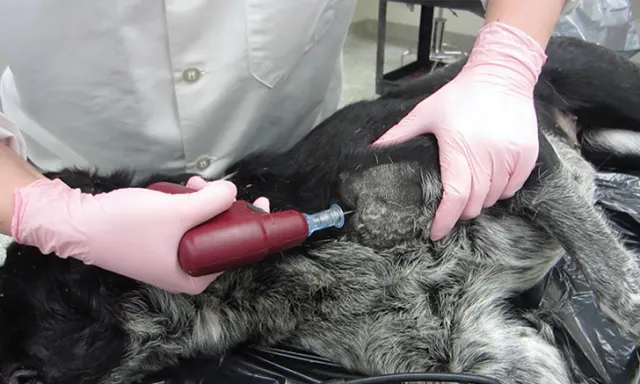Venous Access in Dogs with Cardiovascular Collapse
Marie K. Holowaychuk, DVM, DACVECC, Reviving Veterinary Medicine, Calgary, Alberta, Canada

An IO catheter is inserted into the humerus of a canine cadaver using an automatic rotary insertion device. Image courtesy of Marie K. Holowaychuk, DVM, DACVECC
In the Literature
Allukian AR, Abelson AL, Babyak J, Rozanski EA. Comparison of time to obtain intraosseous versus jugular venous catheterization on canine cadavers. J Vet Emerg Crit Care. 2017;27(5):506-511.
The Research …
Obtaining IV access can be difficult in veterinary patients with cardiovascular collapse or after cardiopulmonary arrest. In such situations, rapid IV access is imperative to facilitate administration of IV fluids and cardiopulmonary resuscitation medications.
This study compared 2 methods of obtaining rapid vascular access in dogs: intraosseous (IO) catheterization of the humerus via an automatic rotary insertion device and IV catheterization via a jugular venous cutdown. Canine cadavers were used as a model for cardiopulmonary arrest; cadavers were placed in lateral recumbency in the emergency room, with all necessary materials in their normal locations, to simulate a hospital CPR setting. An assistant was available to hold off the vein or stabilize the leg for catheterization.
Four categories of catheter placers participated in the study: a veterinary technician specialist certified in emergency medicine, an experienced emergency and critical care specialist, a first-year emergency and critical care resident, and a final-year veterinary student on the emergency and critical care rotation. Verbal instructions on how to perform jugular venous cutdown and place an IO catheter were given. Catheter placement was timed, and fluoroscopy was used to confirm proper placement once complete.
Cadaver body weight ranged from 13.67 lb to 88.18 lb (6.2-40 kg), and median BCS was 5/9. IO catheterization was faster (median, 55.4 seconds) than IV catheterization (median, 217.3 seconds) for all catheter placers. There was no difference in time among catheter placers for IO catheterization; however, time to achieve IV catheterization varied among catheter placers (range, 55.6-614 seconds). The overall success rate for both types of catheter placements was 87.5%.
… To Your Patients
Key pearls to put into practice:
Venous access can be achieved faster using IO catheterization with an automatic rotary insertion device as compared with IV catheterization of the jugular vein in dogs with cardiovascular collapse.
IO catheterization time is not affected by catheter placer experience, whereas jugular catheterization using venous cutdown requires practice and is performed more quickly by experienced personnel.
IO catheterization using an automatic rotary insertion device does not require an incision and enters the medullary cavity of the bone, where vascular collapse does not occur.
The selected IO catheter length must be sufficient to reach the medullary cavity to ensure successful placement.